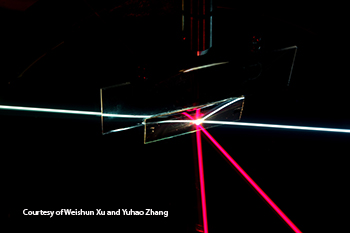
A photograph of the angle-selective sample. The white beam, containing all visible frequencies and projected onto the rectangular area of the sample at a specific angle, passes through as if the sample were a transparent glass. The red beam, incident at a different angle, is reflected as if the sample were a mirror.
Researchers at the Massachusetts Institute of Technology (MIT), Cambridge, Mass. (U.S.A.), have, for the first time, engineered a system that can selectively filter light based only on its propagation direction, independent of frequency. The team believes that the technique could ultimately find applications in technologies ranging from photovoltaics to privacy filters on display screens (Science, doi: 10.1126/science.1249799).
The theory behind the system rests on the Brewster angle—the angle of incidence for a given transparent material at which light of a specific polarization is perfectly transmitted through, with no reflection. In principle, this would allow a system that could permit transmission of p-polarized light at only that angle of incidence, across a range of frequencies. But to make the system work requires also finding a way to arrest the frequency-dependent partial transmission of light coming in from other directions.
Yichen Shen, Marin Soljačić and four other members of the MIT team achieved this by exploiting a second variable: the characteristics of ultrathin photonic crystals. Such crystals have band gaps that prevent light propagation at incidence angles other than the Brewster angle in given frequency ranges.
By combining these “one-dimensional” photonic crystals into an 84-layer stack, and tuning overlap of the band gap between layers, the team was able to widen the effective band gap of the overall sample for incidence angles other than the Brewster angle—maintaining the perfect transmission at the Brewster angle across a broadband spectrum, while shutting down transmission at other angles. The result is a sample that is up to 98 percent transparent to p-polarized light at an angle of incidence of 55 percent, and that behaves like a mirror for light at all other incident angles over the full visible spectrum. A video from the authors demonstrates the system in action.
“We are excited about this,” noted senior author Soljačić, “because it is a very fundamental building block in our ability to control light.” The ability to control light based on propagation direction, without frequency dependence, could, for example, allow the creation of computer or phone displays that would be visible only to those viewing them directly in front, as an aid to computer security, according to the team. And the authors also suggest applications in areas such as high-efficiency solar energy conversion and high signal-to-noise detectors.
